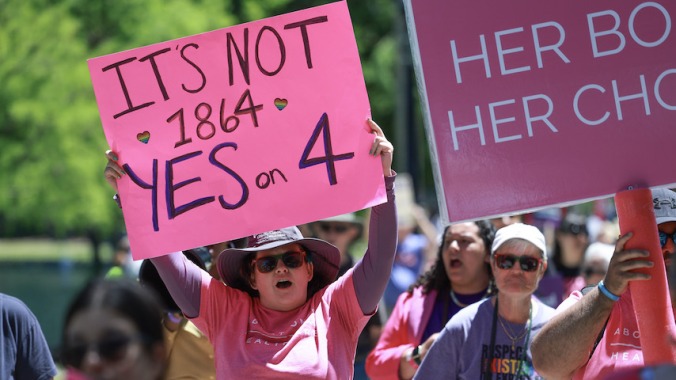There Are 10 Abortion Amendments on the Ballot This Fall. Here’s What They’d Actually Do.
People are rightly energized to vote on abortion initiatives, but the battles will be far from over on November 5.
Photo: Getty Images AbortionPolitics 2024 Election
This November, abortion will be on the ballot both literally and figuratively. Americans will not only be voting for politicians who could impact abortion policy at the federal level, but people in 10 states will cast ballots on abortion-related amendments. In the two years since the Supreme Court overturned Roe v. Wade, abortion ballot measures have, so far, been undefeated: There were six in 2022 and one in 2023, and the pro-choice position has won each time. The majority of the amendments going to voters this fall seek to enshrine abortion rights in state constitutions.
But while statewide votes on abortion are one tool to help shore up access, they won’t solve the healthcare crisis unfolding across the country. Seven of the amendments on the ballot would enshrine the right to abortion only until fetal viability, which is different for every pregnancy but thought to be around 24 weeks. In doing so, these amendments essentially replicate the Roe v. Wade framework that left behind people who need later abortions and opened the door to the criminalization of pregnancy loss. Even if every ballot measure passes—which is far from guaranteed—some residents of those states will still have to cross state lines for care, and people will still face financial barriers to make it to their appointments, a gap that abortion funds work tirelessly to fill.
Here are the states where voters will weigh in on abortion, and what the ballot measures will do:
- Arizona: Proposition 139 would protect access to abortion up to fetal viability, or when necessary to protect the patient’s health. (Abortion is currently banned after 15 weeks of pregnancy.)
- Colorado: Colorado has no gestational limit for abortion care. Amendment 79 would codify the right to abortion in the state constitution and repeal a previous ban on public health insurance plans covering abortion. It needs 55% of the vote to pass.
- Florida: Amendment 4 would protect access to abortion up to fetal viability, or when necessary to protect the patient’s health. It would leave in place current law requiring parental notification for minors seeking abortions. All Florida amendments have to hit a 60% threshold to pass. (Abortion is currently banned after 6 weeks of pregnancy in Florida.)
- Maryland: Maryland has no gestational limit for abortion care. Question 1 would codify the right to reproductive freedom, including abortion and birth control, in the state constitution.
- Missouri: Amendment 3 would codify the right to make reproductive health care decisions, including abortion until viability, birth control, and miscarriage care. (Abortion is banned in almost all circumstances.)
- Montana: Initiative 128 would protect the right to abortion until viability. (Abortion is banned after viability.)
- Nebraska: There are two competing amendments thanks to anti-abortion campaigners. The Protect the Right to Abortion Initiative would enshrine the right to abortion until fetal viability and the other (“Protect Women and Children,” lol) would codify the state’s current 12-week ban. If both measures pass, whichever gets the most votes will become law.
- Nevada: Question 6 would codify the right to abortion up to fetal viability in the state constitution, but has to pass in both 2024 and 2026 in order to take effect. (Abortion is banned after viability.)
- New York: Proposal 1 is an equal rights amendment that would establish a right to reproductive autonomy, including abortion. (Abortion is banned after viability.)
- South Dakota: Amendment G would codify access to abortion in the first trimester and also allow the state to enact restrictions in the second trimester. The state can ban abortion in the last trimester, when a fetus is thought to be viable. (Abortion is currently banned in almost all circumstances.)
One more proposed amendment didn’t make the ballot: Last week, the Arkansas state Supreme Court ruled 4-3 that campaigners didn’t submit the correct paperwork in order for signatures collected by paid canvassers to count. (The Arkansas ballot measure language called for protecting abortion up to 18 weeks post-fertilization, or 20 weeks since a woman’s last menstrual period.)
-

-

-

-

-

-

-

-

-

-

-

-

-

-

-

-

-

-

-

-

-

-

-

-

-

-

-

-

-

-

-

-

-

-

-

-

-

-

-

-








































